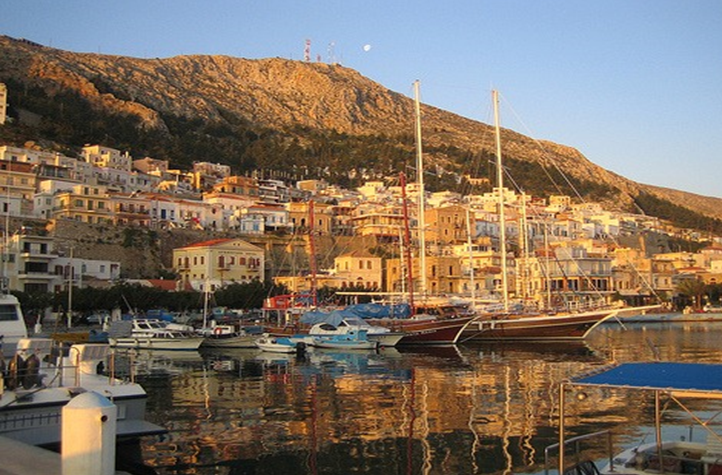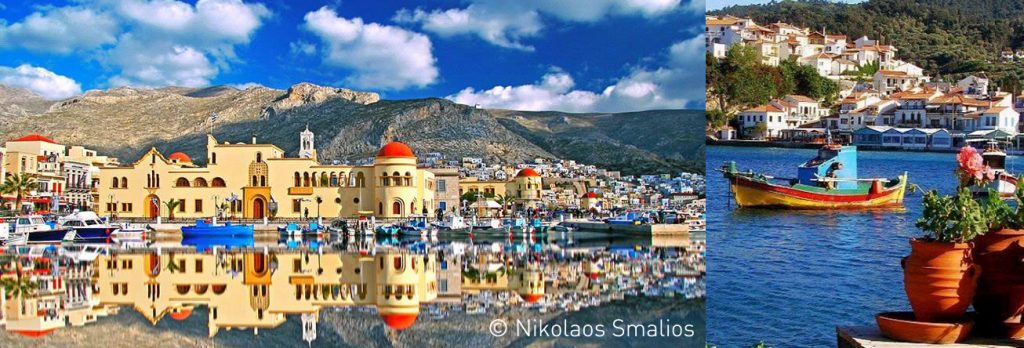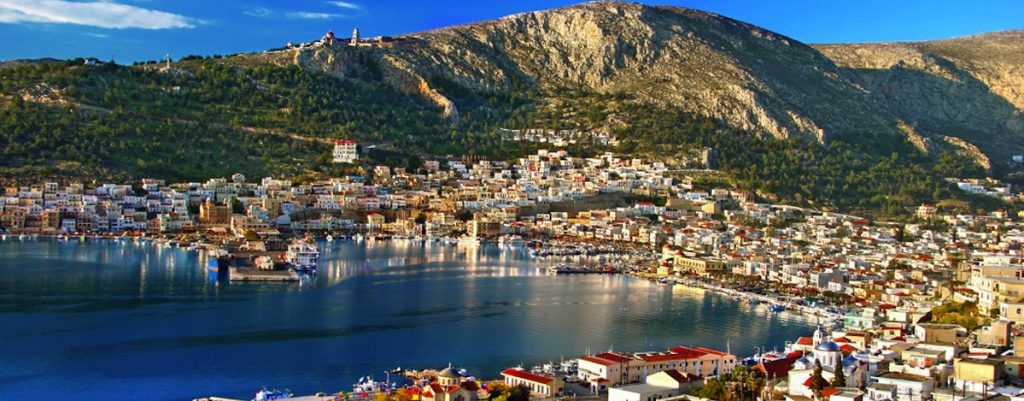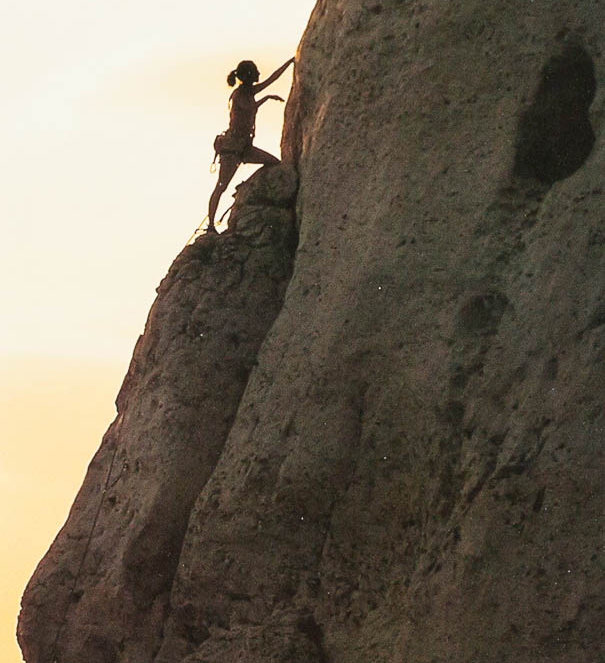


This is the island of the sea-sponge harvesters, hence it is widely known as an international sponge-harvesting trade center. Thanks to its unique geomorphology, Kalymnos is a tourist destination known worldwide for offering alternative vacations and activities such as climbing, scuba diving, mountain hiking and spelunking, a true paradise for passionate action-lovers! The Kalymnian landscape is rocky and arid yet majestic voted the best rock climbing destination in Europe in 2013. The island is generally mountainous, having two small valleys full of lemon trees and many herbs, such as thyme, sage and oregano in which Kalymnos owes its excellent flavor of the honey.
Kalymnos climbing and hiking holidays have become very popular in recent years, and it’s one of Europe’s hottest rock climbing destinations.



The capital of Kalymnos is the port-town of Pothia, a colourful island settlement spreading amphitheatrically over the foot and slopes of two hills and the valley between them. Pothia boasts remarkable architectural features; in its narrow streets, stand next to one another impressive old mansions (among them stands out the Vouvalis Mansion, the house of a prominent sea sponge merchant and benefactor of the island), elegant captain houses and modest one-storey sponge-harvesters’ houses. Each neighborhood has its own church but the most impressive ones are considered to be those of 1861 Sotiras Christos (Christ Saviour), with a silver dome and a marble iconostasis (icon screen) crafted by the eminent Greek sculptor Giannoulis Chalepas and Agios Nikolaos church. Outstanding buildings such as the Town Hall and the Prefecture Hall boasting a beautiful Italianate architecture reveal the long presence of Italian conquerors on the island.

Peer into the island’s history through a visit to the Archaeological Museum, whose major artefact is the copper statue known as the “Lady of Kalymnos”;  the Maritime Museum, dedicated to the life and customs of the sponge harvesters and “Kalymniko Spiti” [the House of Kalymnos], a small folk art museum illustrating everyday life on the island at the end of the 19th and at the beginning of the 20th century. A visit to the castle of Chrysocheria, built in the 15th century by the Knights Hospitaller, is essential; on its foot lies the trademark of the island: three stone-built windmills! When your stroll through the narrow lilliputian streets of Pothia comes to an end and after having enjoyed the panoramic breathtaking view from Agios Savvas church, head to the promenade, pick one of its cute waterfront tavernas and taste delicious local specialties, such as “spinialo”, the sponge-harvesters’ titbit consisting of ray, sea urchins and sea-figs preserved in sea water or “mouri”, stuffed lamb or goat cooked on a metallic baking pan (named gastra).
the Maritime Museum, dedicated to the life and customs of the sponge harvesters and “Kalymniko Spiti” [the House of Kalymnos], a small folk art museum illustrating everyday life on the island at the end of the 19th and at the beginning of the 20th century. A visit to the castle of Chrysocheria, built in the 15th century by the Knights Hospitaller, is essential; on its foot lies the trademark of the island: three stone-built windmills! When your stroll through the narrow lilliputian streets of Pothia comes to an end and after having enjoyed the panoramic breathtaking view from Agios Savvas church, head to the promenade, pick one of its cute waterfront tavernas and taste delicious local specialties, such as “spinialo”, the sponge-harvesters’ titbit consisting of ray, sea urchins and sea-figs preserved in sea water or “mouri”, stuffed lamb or goat cooked on a metallic baking pan (named gastra).
Around Pothia you will find beautiful picturesque hamlets that worth discovering, such as Panormos, Chorio, Skalia und Myrties. One of the island’s highlights is Vathys, a brushstroke of lush vegetation within an infertile rocky terrain lying in a fertile valley of citrus fruit groves, 11km from Pothia.
Did you know that the island has its own fjord?! The port of Rina is a beautiful protected bay which actually reminds us of a small Norwegian fjord!

It’s said that Kalymnos owes its name to the “beauty of the waters that lap against its beaches”; taking this into consideration, it is only natural that on the island you will come across  dreamy beaches, ideal for unforgettable fun dives! One of the most popular beaches is the sandy beach of Masouri, 9km west of Pothia. Therma is the closest beach to Pothia, only 2km away, while Vlychadia (5 km away from Pothia) consists actually of two beaches, a sandy and a pebbly one. Linaria is a family beach, while younger people opt for the cosmopolitan Kantouni beach. Platys Gialos is renowned for its black sand and is suitable for fishing. Emporeios is a favourite among wind and kite surfing lovers. If you want to escape the crowds choose the Bay of Arginontes or the beaches Almyres, Drasonta, Pezonta, Palionisos, Sikati and Petronta, which are accessible only by boat.
dreamy beaches, ideal for unforgettable fun dives! One of the most popular beaches is the sandy beach of Masouri, 9km west of Pothia. Therma is the closest beach to Pothia, only 2km away, while Vlychadia (5 km away from Pothia) consists actually of two beaches, a sandy and a pebbly one. Linaria is a family beach, while younger people opt for the cosmopolitan Kantouni beach. Platys Gialos is renowned for its black sand and is suitable for fishing. Emporeios is a favourite among wind and kite surfing lovers. If you want to escape the crowds choose the Bay of Arginontes or the beaches Almyres, Drasonta, Pezonta, Palionisos, Sikati and Petronta, which are accessible only by boat.
The island that boasts such a long tradition in sponge diving could not be less than the ultimate scuba diving paradise as well! The seabed of the island offers a unique diving experience, where beauty takes the form of forbidding underwater cape slopes, shipwrecks, underwater caves, and reefs of vibrant colour and thriving aquatic life. There are two diving centres and a Public School for Professional Divers on the island (info: Kalymnos Port Authority).
Diving lovers can further attend the “Diving Festival and Skandalopetra Games of Kalymnos”, which presents a full program of various activities on free, autonomous and organised diving; diving fans are brought together at an event that brings back to life traditional sponge diving techniques. The festival offers a fascinating range of activities, for which no participation fees are required: skandalopetra Games, CMAS Apnoea International Judge Course, introduction to CMAS apnoea disciplines, demonstration of traditional sponge diving techniques, visit to Diving Museums, underwater Photography Seminar and Underwater Photography Contest.

A steep, impressive rocky landscape, once perceived as a curse by the inhabitants, has been proved to be a true blessing for climbing lovers. The whole island is a unique natural climbing field with more than 1300 climbing tracks of various levels of difficulty providing a huge range of climbing on slabs, big walls, overhangs and tufas to suit every level and style. The island’s suitability for rock climbing was discovered randomly in 1997 by Italian climbers, who actually established around 40 climbing tracks.  The initiative was later supported by the local community and, as a result, the island today is considered to be one of the top climbing destinations worldwide. Due to the abundance of challenging rock formations, the potential for new routes is enormous; less than 10% has been explored, surrounded by some of the finest limestone crags in the world (the Grande Grotta cave forms a giant limestone amphitheater). Kalymnos also hosts the world-famous Climbing Festival, a non-competitive international meeting attracting top climbers from all over the world!
The initiative was later supported by the local community and, as a result, the island today is considered to be one of the top climbing destinations worldwide. Due to the abundance of challenging rock formations, the potential for new routes is enormous; less than 10% has been explored, surrounded by some of the finest limestone crags in the world (the Grande Grotta cave forms a giant limestone amphitheater). Kalymnos also hosts the world-famous Climbing Festival, a non-competitive international meeting attracting top climbers from all over the world!
Discover the natural beauties of the island through hiking! Follow wonderful scenic routes such as this from Chorio to Kastro of Chrysocheria [Castle of Chrysocheria] (20’-min. hike) or further uphill to the top of Profitis Ilias (total trail length: 5 km). Another hiking route goes from Kalymnos (Pothia) to Vathy (total trail length: 4.5 km) along the old, Italian cobblestone path. On the island there have been also recorded more than 50 caves, linked to fascinating myths and traditions. Indicatively you can visit the Cave of Epta Parthenes (Seven Virgins), the cave of Kephalas with the rich stalactite formations (reachable only by boat from Pothia or Myrties) or Daskaleio (reachable only by boat from the port of Rina).
It only takes 40′ by ferry to get to Kalymnos. The ferry departs from Mastichari port in Kos and to get there, one must take the bus from Kos city centre to Mastichari. Connections are very frequent and closer to our conference dates, we will make sure to post more information.
Organised daily tours are also possible departing by picturesque wooden boats from Kos harbour directly to Kalymnos. The daily cruise takes an hour and half to Kalymnos.
Kalymnos was inhabited in the Neolithic era. The first inhabitants were probably Carians who came from Caria in Asia Minor (modern Turkey), and later followed the Cretans around 1100 BC. The Dorians followed after the Cretans and built a settlement they named Argos.
In the 5th century BC, the Queen of Halicarnassus, Artemisia, with the alliance of Persians conquered the island. During the Persian Wars Kalymnos became part of the Athenian Alliance, and then solidified its relations with neighboring Kos. Later it was conquered by the Romans and in the late 13th century by the Genoese, along with the rest of the Dodecanese.
At that time, they built the Castle Village, also known as Pera Castle. The Knights of the Hierarchy of St. John took control of the island in 1306 until 1522. When faced the onslaught of the Ottomans they withdrew to Rhodes to make the last, unsuccessful resistance on the basis of their country, in the city of Rhodes.
The Ottoman rule lasted about 400 years, until 1912 when the Italians tried to conquer the island of Kalymnos with other Dodecanese islands. Kalymnos finally became part of Greece in 1948, after the forces of the axis were defeated during the Second World War.
After WW II, Kalymnos remained the only Greek island engaged in the sea sponge-harvesting activity, supplying domestic as well as foreign markets.
 http://www.kalymnos-isl.gr/en/
http://www.kalymnos-isl.gr/en/ http://www.visitgreece.gr/en/greek_islands/kalymnos_the_island_of_the_sea_sponge_harvesters
http://www.visitgreece.gr/en/greek_islands/kalymnos_the_island_of_the_sea_sponge_harvesters www.meetingplanner.gr
www.meetingplanner.gr